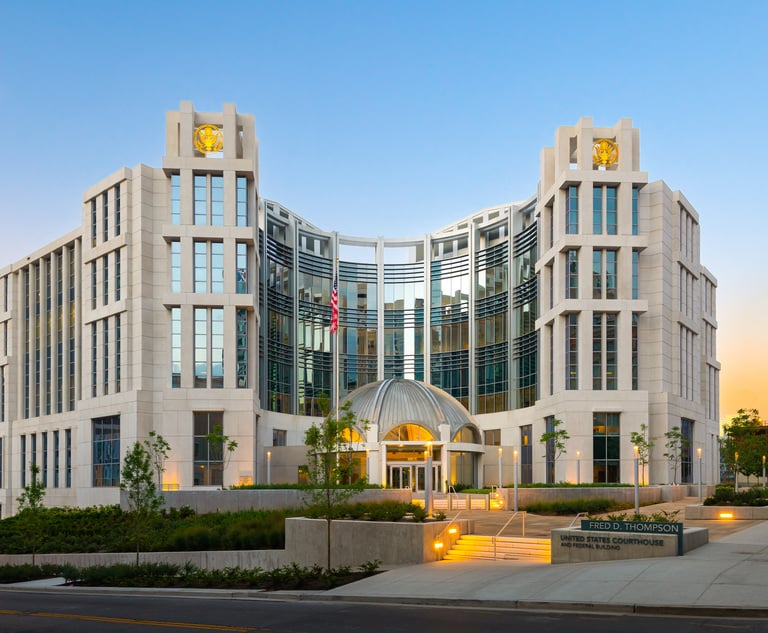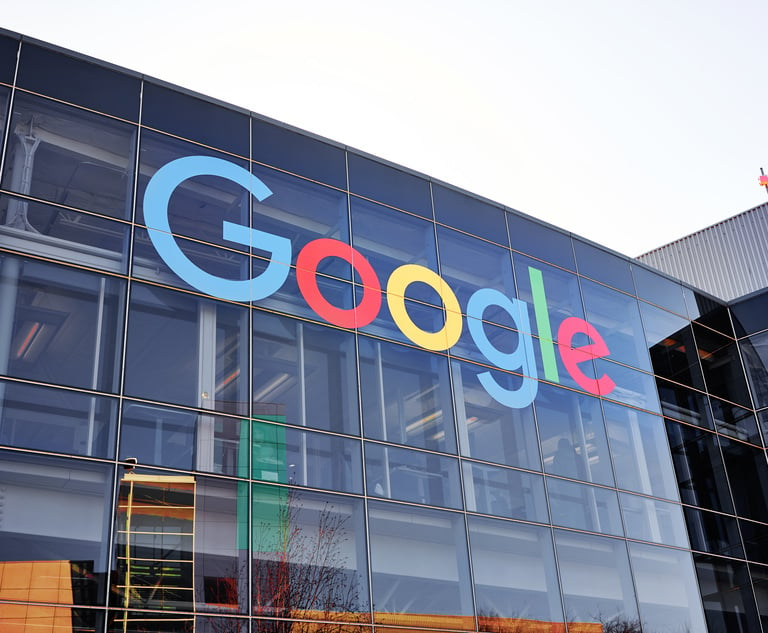New Legal Landscape for Automated, Post-Pandemic World
Littler Mendelson's Natalie Pierce points to the new legal threats for an increasingly automated workforce after the coronavirus pandemic.
April 29, 2020 at 06:24 PM
4 minute read
The original version of this story was published on The Recorder
 Natalie Pierce, a Littler Mendelson shareholder (Photo: Jason Doiy/ALM)
Natalie Pierce, a Littler Mendelson shareholder (Photo: Jason Doiy/ALM)
Right about now, it might feel like we're submerged in uncertainty. But one thing that seems absolutely certain is that the world probably won't look the same after the COVID-19 pandemic is over.
To comply with social distancing and keep workers safe, some retailers are using robots to scrub floors, and recycling facilities are using robots to sort potentially contaminated items. On the front lines, some hospitals are disinfecting patient rooms with robots that zap the virus with ultraviolet light, and treating patients with remote-controlled telehealth robots.
Natalie Pierce, a Littler Mendelson shareholder in San Francisco and co-chairwoman of the firm's robotics, artificial intelligence and automation practice group, said that even after the pandemic subsides, employers might see the benefits of collaborative robots, or cobots, autonomous mobile robots, and other automated tools to help socially distance their workforce. But as employers adopt artificial intelligence and robots at a rapid rate, they have a new fresh set of legal hurdles to consider—and fast.
The Recorder asked Pierce some questions about how businesses are changing during this extraordinary time. Answers have been edited for length and clarity.
➤➤ Where are you seeing an acceleration in the adoption of AI and automation? Minimizing touches is going to become a very big deal, I think even post-pandemic, not just to increase safety levels for employees and customers, but I think the lesson learned will be that adoption is easy. The cost has really come down. These robots are able to work in tight spaces and around people. For example, we're seeing grocery stores take measures to comply with social distancing protocols by using robots for cleaning, scanning, stocking and even delivery. It's clear that the coronavirus has simply accelerated that trend, and we can expect to see greater adoption by grocers of all sizes post-pandemic. We already know they increase safety and efficiency and reduce laborious work during a time when it's often scary and exhausting to be an essential worker.
For more on the future of law, sign up for What's Next.
➤➤ Are our legal frameworks ready for more automated workplaces? We really cannot expect that regulations will keep up with technology, and I'm not sure we really want it to, because it can stifle innovation. What we see across the globe increasingly is an effort to standardize principles—whether they be legal, ethical or safety principles—around the adoption of AI. We're certainly seeing that with some of the supply chain issues we're having. There are efforts to try to onshore, or at least local shore, more of the operations, so as to avoid these global supply chain breakdowns. What end users sometimes see is, "Oh, well, we have these different local standards for how we can deploy this cobot for this particular function." Now that we've gone through this, and see how difficult it is, there will be greater calls for standardization of robotics as well. We have organizations working together, such as the Robotics Industries Association, OSHA, ANSI, the ISO, in coming up with those guidelines and standards. You will also see more certification of integrators, who go between the manufacturer and the end user to deploy robotic solutions.
➤➤ What legal implications do you expect to see with accelerated adoption of AI and robotics? If it's organized labor, you're always going to have the issues around: Do we need to bargain with the union? There are other obvious issues like making sure there isn't a protected category of employees who is excluded. You're going to want to avoid a tendency to think if you weren't born in a digital, native generation, you're going to have a tougher time becoming a robot supervisor or working with this specific kind of technology. The educational opportunities and training opportunities are going to become really important. As we replace the mundane, repetitive tasks, we will need employees who have collaborative skills and who are capable of gaining different technical skills and are creative. Historically, we don't see that automation of jobs leads to loss of jobs. What we see is more efficiency and productivity that leads to different kinds of jobs. It's tough, because things are accelerated and everything is upside down right now. I think everyone realizes that, post-pandemic, things just won't be the same.
This content has been archived. It is available through our partners, LexisNexis® and Bloomberg Law.
To view this content, please continue to their sites.
Not a Lexis Subscriber?
Subscribe Now
Not a Bloomberg Law Subscriber?
Subscribe Now
NOT FOR REPRINT
© 2025 ALM Global, LLC, All Rights Reserved. Request academic re-use from www.copyright.com. All other uses, submit a request to [email protected]. For more information visit Asset & Logo Licensing.
You Might Like
View All
Lavish 'Lies' Led to Investors Being Fleeced in Nine-Figure International Crypto Scam
3 minute read
Meta Hires Litigation Strategy Chief, Tapping King & Spalding Partner Who Was Senior DOJ Official in First Trump Term

Law Firms Mentioned
Trending Stories
- 1Arbitrators Under Fire for Allegedly Forcing Workers to 'Stay or Pay' Employers
- 2Plaintiff Narrowly Avoids Dismissal Over Lengthy Complaint Filed in Federal Court
- 3Goodwin to Launch Brussels Office With Quinn Emanuel Antitrust Partner
- 4Looking to the Future of the FDA and Its Impact on Drug Regulation in 2025
- 5Pennsylvania Firms Join Partnership Promotion Parade
Who Got The Work
Michael G. Bongiorno, Andrew Scott Dulberg and Elizabeth E. Driscoll from Wilmer Cutler Pickering Hale and Dorr have stepped in to represent Symbotic Inc., an A.I.-enabled technology platform that focuses on increasing supply chain efficiency, and other defendants in a pending shareholder derivative lawsuit. The case, filed Oct. 2 in Massachusetts District Court by the Brown Law Firm on behalf of Stephen Austen, accuses certain officers and directors of misleading investors in regard to Symbotic's potential for margin growth by failing to disclose that the company was not equipped to timely deploy its systems or manage expenses through project delays. The case, assigned to U.S. District Judge Nathaniel M. Gorton, is 1:24-cv-12522, Austen v. Cohen et al.
Who Got The Work
Edmund Polubinski and Marie Killmond of Davis Polk & Wardwell have entered appearances for data platform software development company MongoDB and other defendants in a pending shareholder derivative lawsuit. The action, filed Oct. 7 in New York Southern District Court by the Brown Law Firm, accuses the company's directors and/or officers of falsely expressing confidence in the company’s restructuring of its sales incentive plan and downplaying the severity of decreases in its upfront commitments. The case is 1:24-cv-07594, Roy v. Ittycheria et al.
Who Got The Work
Amy O. Bruchs and Kurt F. Ellison of Michael Best & Friedrich have entered appearances for Epic Systems Corp. in a pending employment discrimination lawsuit. The suit was filed Sept. 7 in Wisconsin Western District Court by Levine Eisberner LLC and Siri & Glimstad on behalf of a project manager who claims that he was wrongfully terminated after applying for a religious exemption to the defendant's COVID-19 vaccine mandate. The case, assigned to U.S. Magistrate Judge Anita Marie Boor, is 3:24-cv-00630, Secker, Nathan v. Epic Systems Corporation.
Who Got The Work
David X. Sullivan, Thomas J. Finn and Gregory A. Hall from McCarter & English have entered appearances for Sunrun Installation Services in a pending civil rights lawsuit. The complaint was filed Sept. 4 in Connecticut District Court by attorney Robert M. Berke on behalf of former employee George Edward Steins, who was arrested and charged with employing an unregistered home improvement salesperson. The complaint alleges that had Sunrun informed the Connecticut Department of Consumer Protection that the plaintiff's employment had ended in 2017 and that he no longer held Sunrun's home improvement contractor license, he would not have been hit with charges, which were dismissed in May 2024. The case, assigned to U.S. District Judge Jeffrey A. Meyer, is 3:24-cv-01423, Steins v. Sunrun, Inc. et al.
Who Got The Work
Greenberg Traurig shareholder Joshua L. Raskin has entered an appearance for boohoo.com UK Ltd. in a pending patent infringement lawsuit. The suit, filed Sept. 3 in Texas Eastern District Court by Rozier Hardt McDonough on behalf of Alto Dynamics, asserts five patents related to an online shopping platform. The case, assigned to U.S. District Judge Rodney Gilstrap, is 2:24-cv-00719, Alto Dynamics, LLC v. boohoo.com UK Limited.
Featured Firms
Law Offices of Gary Martin Hays & Associates, P.C.
(470) 294-1674
Law Offices of Mark E. Salomone
(857) 444-6468
Smith & Hassler
(713) 739-1250









